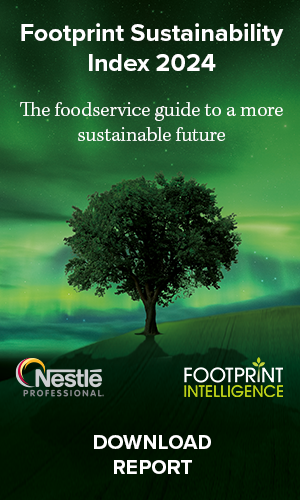With soya production considered a major driver of deforestation, it’s high time the foodservice industry acted more responsibly when it comes to sourcing this key commodity, writes David Burrows
“If 2018 was the year that problems with palm oil (finally) boiled over, this year’s commodity under attack promises to be soya.” I wrote that back in January. For those blissfully unaware of the soya storm on the horizon, the past few weeks has served as a rude awakening. The wildfires raging in the Amazon have made this small bean big, big news. But does the food industry really care?
I am sure some businesses do. But look at the general picture and the attitude has, to put it bluntly, been “meh”.
HOW DID WE GET HERE?
In 2010, The Consumer Goods Forum (CGF) admitted that “the consumer goods industry, through its growing use of soya, palm oil, beef, paper and board, creates many of the economic incentives which drive deforestation”. So its 400 members – including the likes of Tesco, Unilever, Nestlé, Cargill and Tyson – pledged to “achieve zero net deforestation by 2020”.
With 100 or so days left that is clearly not going to happen. Fine words have not delivered favourable action. Figures released in June by IDH, the sustainable trade initiative, show that in 2017 the UK used just over 2.7m tonnes of soybeans, soymeal and soybean oil, of which 37% was “responsible” (compliant with the European Feed Manufacturers’ Federation’s Soy Sourcing Guidelines) and 14% was deforestation-free. This was slightly better than the European averages (22% and 13% respectively).
The impact of this lack of demand for responsible soya was laid bare in Greenpeace’s June report, Countdown to Extinction: since 2010, 50m hectares of forest (about twice the size of the UK) has been destroyed to grow a range of deforestation-linked commodities, including soya. More worrying was how little the big food brands knew about the soya in their businesses. As the NGO noted: “Brands do not even know the volume or origin of the animal feed in their meat and dairy supply chains – a huge oversight, as soya is the second most significant driver of global deforestation and 90% of soya produced worldwide is used for animal feed.”
Manufacturers and retailers were the focus of that report, but there is every chance foodservice and hospitality are equally ignorant. If not more so.
IRRESPONSIBLE AND IGNORANT
In 2014 Footprint highlighted the “lazy buying practices” of foodservice companies when it comes to soya. They hadn’t been challenged on the issue, said the WWF, which gave them an excuse to brush things under the carpet. That laissez-faire attitude by and large persisted when the WWF looked again in 2016.
More recent research suggests little has changed. Published in July, The Money Trees report from environmental impact charity CDP shows Domino’s, Greene King, Dairy Crest, Aramark, Mondelēz and Ikea among a list of more than 350 companies continually failing to report on the impact their operations have on the world’s forests. Smithfield is perhaps the exemplar in flexible corporate reporting: the world’s largest pork processor offered up information on the sourcing of timber used in its packaging but not for the vast amounts of soya used to feed the pigs.
“Global consumption of soya, mainly through animal feed, is one of the largest causes of deforestation from agricultural products and represents just over a fifth of total deforestation embodied in trade,” explains Morgan Gillespy, global director of forests at CDP. However, there is a “chronic lack of corporate transparency on deforestation, with 70% of the companies requested to disclose data in 2018 failing to do so”.
Many also seem oblivious to the physical forest-related risks to their business, which could lead to a drop in agricultural production for example, having focused instead on the reputational risks. Downstream companies, like retailers and hospitality, appear particularly exposed, and are struggling with deforestation embedded within products, especially when it is not a direct ingredient but forms part of previous production steps.
Gillespy explains: “Soya’s most prevalent use is as animal feed to produce animal protein products and this is where its biggest deforestation footprint lies. [However, their] analysis still tends to be limited to products that directly contain soya – for example, soya sauce or soymilk – as opposed to products that have ‘embedded soya’ such as meat, dairy and pet food.”
SCRAMBLE TOWARDS SUSTAINABLE SOYA
Some caterers have begun to look more closely: Compass has traced 51-60% of the soya in its supply chain to country, while Sodexo has traced 100%, but didn’t specify to which point, according to CDP. Tesco, meanwhile, has completed the mapping of its UK supply chain for soya – and it’s the retailers that seem to be leading the way.
UK supermarkets turned their attention to soya when they realised the 2020 CGF target wouldn’t be met, before the fires in Brazil hit the news. In the past few months, commitments through the recently established UK Roundtable on Sustainable Soya (RTSS, which is not to be confused with the RTRS – the Round Table on Responsible Soy) have come thick and fast. Aldi, Asda, Co-op, Lidl, Marks and Spencer, Sainsbury’s, Tesco and Waitrose – which together represent 1.2m imported tonnes of soya – have now published action plans detailing how they are going to deliver on their promises. But foodservice, publicly at least, hasn’t joined in.
WWF-UK is assessing the various commitments with an analysis due this autumn. Its head of food commodities, Emma Keller, says there has been a “positive scramble” to succeed. However, throw Brexit and trade deals into the mix and there is concern among producers they will be “unfairly disadvantaged” as supermarkets shift through the sustainability gears. Let’s not forget that farmers have been down this path before: a few years ago retailers committed to GM-free feed but the promises were mostly shelved after they realised just how expensive it would be.
When CGF made its 2010 statement there were reassurances that deforestation-free soya wouldn’t be more expensive: “… if the crops were grown sustainably, yields would rise and inputs would fall”. This hasn’t happened, but the price premium reportedly putting companies off sourcing RTRS beans amounts to 1% (or $2 to $3 per tonne). This might not seem much, but livestock producers are nonetheless concerned it’ll be them picking up the tab. “There are lots of retailers busily making commitments, and as always these come with a cost and as always this is passed on to producers,” the National Pig Association said recently.
The other issue with GM-free soya was availability. However, there is plenty of RTRS soya to go around. There were 4.5m tonnes of it available last year, but only 2.8m tonnes was bought at the premium rate for responsible soya, the rest being sold as ‘standard’ soya. All schemes are having difficulty selling their responsible soya, says Nienke Sleurink, program manager deforestation commodities at IDH. “Scheme owners have indicated that if demand rises significantly, supply can easily follow. While we do not know exactly what the tonnage covered by deforestation-free commitments is, the question is not if there is enough soy to supply it, but if there is enough actual demand.”
WHERE THERE’S A WILL…
The WWF-UK’s Keller says “every bean” could be zero deforestation and zero conversion (non-forest natural habitats) within 12 months. “Production could double or triple by 2050 without chopping down a single tree,” she explains, provided there is the right commercial and political will. Food businesses have been at pains to highlight the “indispensable role” governments play in all this. As CGF co-chairs Marks and Spencer and Unilever noted in 2015: “Our supply chains are significant but they are often only one factor in the complex web of causes of deforestation. We know that the next stage in the journey to tackle deforestation is to create solutions at a jurisdictional (whole landscape) level to manage the many causes of forest loss together, rather than through individual, isolated initiatives.”
Almost five years on and between the three major suppliers of soya – Brazil, Argentina and the US – you’d be hard-pressed to choose the least politically stable at the moment. Calls for an import ban on soya have already started. Food charity Feedback, for example, puts forward the argument that all demand for soya increases pressure on land overall, so “there is no such thing as sustainable soya”. It has a point. Cattle ranchers are selling up land to soya producers and moving somewhere cheaper, often forests – a phenomenon known as ‘land use cascade’. One study calculated that a 10% reduction in soya expansion into cattle pasture areas between 2003 and 2008 would have reduced Amazon deforestation by as much as 40%.
However, a ban on imports would be a blunt tool, and a full assessment of the unintended consequences is essential. Nevertheless, it’s easy to see brands jumping on this bandwagon, as they have with palm oil. In a YouGov poll of 2,106 UK consumers published in May, 66% said the government isn’t doing enough to tackle deforestation. It was part of a wider poll of almost 21,000 Europeans, of which 87% want new laws to protect forests.
After this summer of fires, brands will be feeling the heat. Those hoping to remain blissfully ignorant of the soya hidden in their supply chain will get burned. In the words of Greta Thunberg: “I want you to act as you would in a crisis. I want you to act as if our house is on fire. Because it is.”














